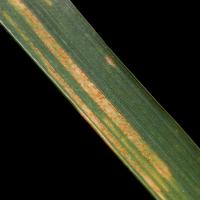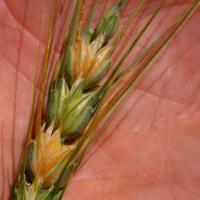Diagnosing stripe rust of wheat
Stripe rust is a fungal foliar disease specific to wheat that can cause up to 60% yield loss and reduce grain quality, particularly when susceptible varieties are infected early.
What to look for
- First signs often are ‘hot spots’ of rust infection which show up in paddocks. They can be seen from a distance as yellow patches 1-10 metres in diameter.
Paddock
- Yellow-orange pustules are arranged in stripes along the leaf veins.
- On seedling leaves, small yellow-orange pustules are scattered on upper surface.
- In severe cases, heads become infected with spores forming inside glumes and on awns.
- Colour of pustules depends on the freshness of the pustule. Because most spores are produced overnight, pustules are best observed in the morning.
Plant
What else could it be
| Condition | Similarities | Differences |
|---|---|---|
| Diagnosing stem rust of wheat | Powdery pustules | Stem rust pustules often go through to the other side of the leaf. |
| Diagnosing leaf rust of wheat | Powdery pustules | Leaf rust pustules are scattered on leaves. |
Where did it come from?

Green bridge

Wet conditions
- Risk of early infection is increased when summer-autumn rains enable the fungus to survive between seasons on susceptible varieties of volunteer wheat.
- The disease is favoured by cool, moist conditions (7-15°C) so is relatively more active in winter than later in the season. A stripe rust epidemic is more likely if the winter is suitably wet. The latent period of stripe rust (approximate time taken for an infection to result in new spores being produced) is 10-14 days in these optimal temperature conditions. Warm spring conditions, particularly in the northern agricultural areas, can increase the latent period and slow the development of disease.
- Stripe rust can spread rapidly within and between wheat crops. Spores are readily dispersed by wind and can be carried on clothing. Thoroughly wash potentially contaminated clothes and shoes before visiting crops and consider farm biosecurity measures to minimise likelihood of visitors introducing spores to your property.
- To identify any stripe rust pathotypes that are new to Western Australia, growers and consultants are encouraged to send rust samples to the Australian Cereal Rust Control Program at the University of Sydney.
Management strategies

Resistant varieties

Green bridge control

Spraying fungicide

Spraying foliar
- Avoid sowing susceptible varieties. Use resistant or intermediate varieties wherever possible.
- Destroy greenbridge wheat at least four weeks prior to seeding (earlier to conserve soil moisture), particularly more susceptible wheat volunteers that readily harbour rust over summer and autumn).
- Registered seed or in-furrow fungicide treatments can provide protection until flag leaf emergence depending on disease pressure and application rates.
- A registered foliar fungicide should be applied at the first sign of rust according to the stage of crop development and variety susceptibility if early fungicide was not applied or protection has worn off.
Economic and financial considerations
To assist in assessing the economic risk and financial costs associated with various treatment strategies go to MyEconomicTool
There may be other economic and financial implications that need to be considered when choosing a management option. These may include:
Pre-crop- Assess the risk of stripe rust occurring.
- Understand the potential yield losses associated with infection.
- Assess the costs and benefits of taking preventative action.
- Compare the costs, benefits and risk of each management option against doing nothing.
- Consider risk and associated costs or savings of delaying treatment.
- Consider the potential risk of re-infection and costs of further treatment.
- Ignore all previous treatment costs in assessing current management options.
- Undertake a ‘what if’ scenario analysis to see what impact changing variables (e.g. grain price and seasonal conditions) have on the economic outcome.
- Consider longer term consequences of not adequately treating stripe rust.
View these economic considerations in more detail.
See also
Where to go for expert help
Page last updated: Tuesday, 3 May 2016 - 9:57am




